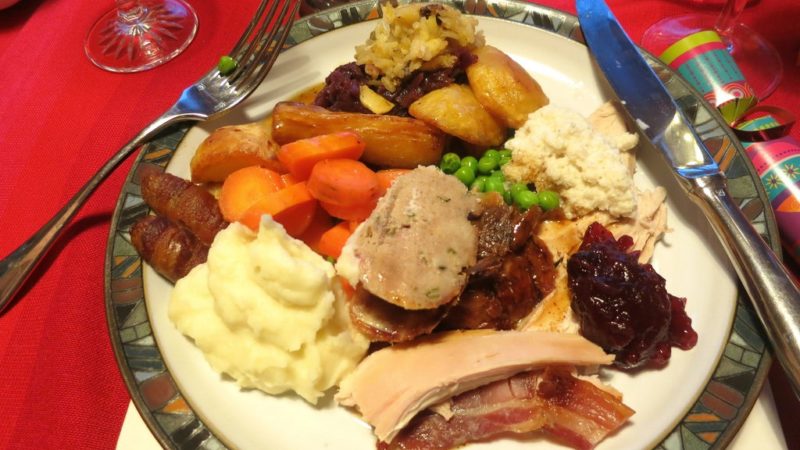Changing the type and amount of meat you eat this Christmas could go a long way to reducing your environmental footprint, according to new analysis for Left Foot Forward.

In an ideal world, turkey would march diligently to the dinner table and sacrifice themselves to the platter, gammon would tumble in on the snowdrift of a white Christmas and beef roast would materialise in stockings overnight.
But, sadly, the food we eat requires watering, feed, growth and transportation, and all these factors leave an accumulative carbon footprint.
From chestnuts to lamb, cauliflower to pork, researchers over the years have made varying attempts to calculate the CO2 equivalents in their production.
One report compiles information from 369 published studies to estimate how much emission is produced by farming through crop growth, enteric fermentation producing methane, manure and other factors.
It finds that beef is responsible for 28kg more greenhouse gasses than vegetables per kilogram of food produced, while lamb gives off 27kg more and pork 5kg more.
With all the data out there, we could throw figures around like some eco-hippie snowball fight until Boxing Day, but what does it actually mean? And would it help if we ate less meat?
The impact of meat production
Food production makes up approximately a fifth of the greenhouse gas (GHG) which the UK is responsible for, and the lion’s share of that comes from animal farming.
This is partly because of how inefficiently energy is converted from feed, to livestock, to food. For every 100 calories used to feed animals, only around 17-30 are carried over onto the dinner table.
On the lower end, that’s equivalent to ordering a pizza, eating one and a half slices and then binning the rest.
Another key cause is enteric fermentation, the biological term for farts produced by livestock, which emit the greenhouse gas methane.
FAOSTAT records estimate that sheep in the UK produced nearly 270 thousand tonnes of methane in 2014. It is difficult to quantify that amount using the usual comparisons: a whale, a Boeing 747 – it comes down to around the same weight of CO2 equivalents delivered from 25,000 return trips between London and Melbourne, Australia.
That’s quite a lot of emissions, but, short of foregoing the beef-turkey-chicken fest this year, we’re not likely going to give up meat en masse in the UK.
But we can look at the effects of our decisions at the dinner table. A study looking at the average emission associated with actual diets, estimates that someone eating more than 100g of meat a day can be responsible for almost twice the GHG emission as someone eating less than 50g, with the trend decreasing towards veganism.
Another study, which assesses the effects of cutting Europe’s meat and dairy intake, predicts that cutting animal production by 25-50% in Europe would result in an almost proportional reduction of 25-40% in greenhouse gases.
The possibility of cutting our GHG emissions like this is tantalising, and can be achieved by making small changes on a large scale.
So let’s start by looking at what has the biggest impact by comparing the average Christmas dinner.
The carbon footprint of a roast
Our analysis of data on the environmental impacts of agricultural production systems, efficiency and food choice suggests there is a hefty impact to changing the amounts or type of meat you serve with your roast.
Assuming an average serving of 250g (roughly eight ounces), the average beef or lamb roast dinner is responsible for around 7kg of greenhouse gasses.
If serving for six people, that works out at around 44kg of CO2 emissions for the whole meal – and that’s excluding stuffing, gravy or booze.
By contrast, a chicken roast dinner is responsible for just a seventh of the equivalent CO2 emissions as a beef one.
Most people have turkey at Christmas – that produces three times as much CO2 as chicken.
Average CO2 emissions per six-person serving of roast dinner ingredients (figure above pics):

Can we change?
The environmental impact is clear, but behavioural change can start at home or from a government level. In December, analysts from the Farm Animal Investment Risk and Return (Fairr) Initiative released evidence showing that meat products are following a pathway towards being taxed in similar ways to tobacco, carbon and sugar.
While governments have long imagined the tax to be unpopular, there is a growing sense that there is low public awareness of the health and environmental risks surrounding high meat diets.
A tax has already been discussed in European parliaments in Denmark, Germany and Sweden.
This Christmas, reducing meat consumption is a personal rather than a legislative decision. But the statistics certainly suggest that even a little can go a long way to solving climate change.
Chad Greggor is a freelance journalist, writing on the environment and politics. Follow him on Twitter.




2 Responses to “REVEALED: The carbon footprint of your Christmas dinner”
greg
What is the point of cutting down on GHGs when we are destroying our natural ecosystems by the acre – we will have to build 300.000 houses every year to simply stand still in the UK and these will contribute massively to the Urban Heat Island effect.
The EU is also now destroying our forests for fuel – cow farts seem a minor problem to my mind
Dave Roberts
Don’t eat meat. I stopped thirty years ago and it’s done me no harm.